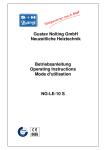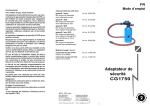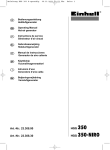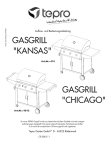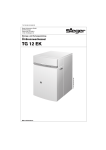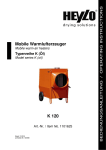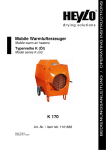Download Betriebsanleitung Operating Instructions Mode d
Transcript
Gustav Nolting GmbH Neuzeitliche Heiztechnik Betriebsanleitung Operating Instructions Mode d′utilisation NG- 15 / 35 / 50 / 75 / 100 -0- INHALTSVERZEICHNIS 1. Technische Daten.................................................... Seite 2 2. Allgemeines.............................................................. Seite 3 3. Sicherheitseinrichtungen.......................................... Seite 3 4. Aufstellung/Montage................................................ Seite 3 - 4 5. Inbetriebnahme........................................................ Seite 4 6. Ausserbetriebnahme................................................ Seite 4 7. Wartungsarbeiten..................................................... Seite 4 8. Mögliche Störungen und deren Ursachen................ Seite 5 9. Ersatzteillisten und Bauteileübersicht...................... 10. Elektrische Schaltpläne............................................ Seite 9 - 11 Seite 6 - 8 ENGLISH.................................................................. Page 12 - 22 FRANÇAIS............................................................... Pages 23 - 33 06.10.05 NG_DE_EN_FR_7.doc -1- WICHTIG! UNBEDINGT LESEN! Lesen Sie die Anleitung vor der Inbetriebnahme des Gerätes sorgfältig durch. Bei Nichtbeachtung erlischt der Gewährleistungsanspruch. Für Schäden und Folgeschäden, die daraus entstehen, übernimmt der Hersteller keine Haftung. 1. TECHNISCHE DATEN Typ NG-15 NG-35 NG-50 NG-75 NG-100 Nennwärmebelastungsbereich kW 7,0 – 14,0 18,0 – 35,0 25,0 – 50,0 35,0 – 70,0 50,0 – 100,0 Luftleistung m³/h 480 1.100 1.400 2.000 2.800 Anschlußdruck bar 2,5 – 10,0 2,5 – 10,0 2,5 – 10,0 2,5 – 10,0 2,5 – 10,0 Anschlußwert kg/h 0,54 – 1,09 1,41 – 2,73 1,95 – 3,91 2,73 – 5,47 3,91 – 7,81 A 0,48 0,48 0,48 0,60 0,92 Länge mm 500 500 650 800 1.000 Breite mm 220 320 320 370 370 Höhe mm 320 460 460 520 520 Gewicht kg 8,0 14,0 16,0 21,0 26,0 Elektroanschluß V CE-0085 AQ 0232 CE-0085 AQ 0232 Stromaufnahme 230/50 Gasart / Kategorie Produkt-ID-Nr. Steuerungsmöglichkeiten Flüssiggas / I 3 P CE-0085 AQ 0806 Halbautomat mit PiezoZündung CE-0085 AQ 0232 CE-0085 AQ 0232 Vollautomatisch mit elektrischer Zündung Anschluß von Raumthermostat über Steckverbindung möglich Technische und maßliche Änderungen vorbehalten. -2- 2. ALLGEMEINES 4. AUFSTELLUNG / MONTAGE Gasbefeuerter Warmlufterzeuger (WLE) für Gewerbe und Industrie. Baureihe NG-15 als Halbautomat mit Piezo-Zündung und thermoelektrischer Flammenüberwachung bzw. Baureihe NG-35 bis NG-100 als Vollautomat mit elektrischer Zündung und Ionisationsüberwachung. Um Personenund Sachschäden zu vermeiden sind die jeweiligen örtlichen Bau-, Brandschutz- und Berufsgenossenschaftsvorschriften unbedingt zu beachten. Vor der Aufstellung ist sicherzustellen, daß die örtlichen Versorgungsbedingungen (Gasart, Druck) und die gegenwärtige Einstellung des WLE übereinstimmen. 3. SICHERHEITSEINRICHTUNGEN Der WLE darf nur in gut belüfteten Räumen, nicht in Wohnräumen oder gleichartigen Aufenthaltsräumen, betrieben werden. 3.1 Sicherheitseinrichtungen NG-15 Als Sicherheitseinrichtung gegen eine Überhitzung wurde der WLE mit einem Thermoschalter (Pos.3) ausgestattet. Um die MAK Grenzwerte im Aufstellungsort einzuhalten, muß pro KW Geräteleistung eine Frischluftmenge von mindestens 25 m³/h gewährleistet sein. Der Thermoschalter schaltet den WLE beim Überschreiten der fest eingestellten Temperatur aus. Der Betrieb in feuer- und explosionsgefährdeter Umgebung ist unzulässig. Nach der Auskühlung des WLE muß zuerst die Ursache behoben und der WLE von Hand in Betrieb genommen werden (siehe Inbetriebnahme Seite 4). Der WLE wird ohne Kaminanschluß auf ebenem Untergrund frei im Raum aufgestellt. Der Abstand zu brennbaren Bauteilen sollte mindestens 1,5 m, auf der Geräteausblasseite mindestens 3 m betragen. Der WLE ist zur Flammenüberwachung mit einer thermoelektrischen Zündsicherung ausgestattet (Pos. 5). Beim Erlöschen der Flamme wird die Gaszufuhr sofort unterbrochen. Das Anbringen von Rohren, Schläuchen o.ä. sowie Veränderungen des Querschnittes sind ausblas- und ansaugseitig nicht zulässig. 3.2 Sicherheitseinrichtungen NG-35 – 100 Als Sicherheitseinrichtung gegen eine Überhitzung wurde der WLE mit einem Sicherheitstemperaturbegrenzer (STB) ausgestattet (Pos. 15). Achtung !!! Elektro- und Gasanschluß des WLE nur vom Fachmann nach den geltenden örtlichen Vorschriften durchführen lassen! (In Deutschland z.B. TRGI und TRF) Der STB schaltet den WLE beim Überschreiten der fest eingestellten Temperatur aus. Die integrierte Wiedereinschaltsperre verhindert einen erneuten Start des Gerätes. Elektroanschluß: Nach der Auskühlung des WLE muß zuerst die Ursache behoben und der STB von Hand entriegelt werden. Der Entriegelungstaster befindet sich am Schaltkasten unter der schwarzen Schraubkappe (Pos. 24). Danach den Entstörknopf des Gasfeuerungsautomaten an der Vorderseite des Schaltkastens drücken (Pos. 16). Der Elektroanschluß erfolgt über ein angebautes Netzkabel mit Schutzkontaktstecker an ein 230V/50 Hz Wechselstromnetz. Die eingebaute Ionisationselektrode dient als Flammenüberwachung und ist an einen Gasfeuerungsautomaten angeschlossen, der die Gesamtfunktion des WLE steuert und überwacht. Als Zubehör kann der WLE mit einem 3,0 m langen Gasschlauch, Schlauchbruchsicherung und einem entsprechenden Druckregler mit Kombi-Flaschenanschlußgewinde ausgestattet werden. Die Verbindung an eine Gasleitung hat Gasanschluß: Am Gerät 3/8“ Außengewinde mit Innenkonus (Linksgewinde beachten). -3- Sollte sich die Flamme nach Ablauf der Zündzeit nicht gebildet haben, wird der o.g. Zündvorgang bis zu viermal wiederholt. Hat sich danach immer noch keine Flamme gebildet, schließt das Magnetventil (Pos. 9) automatisch die Gaszufuhr. Erlischt die Flamme während des Betriebes, schließt ebenfalls das Magnetventil sofort die Gaszufuhr. mit geeigneten Übergangsstücken zu erfolgen (Linksgewinde beachten). Da es ggf. regionale Unterschiede in der Gaszusammensetzung gibt, ist bei der Inbetriebnahme vor Ort das einwandfreie Zünden zu kontrollieren. Bei nicht einwandfreier Zündung ist die Position der Zündelektrode anzupassen. In angemessenen Abständen sollte diese Kontrolle wiederholt werden. Der Gasfeuerungsautomat hat eine Störabschaltung und Verriegelung durchgeführt. Die rote Störlampe am Schaltkasten leuchtet. Der zu verwendende Druckregler muß unbedingt in seiner Leistung den WLE-Daten entsprechen (Anschlußdruck und Anschlußwert). Sobald die evtl. Störung behoben ist, kann das Gerät nach ca. 60 Sek. durch Drücken des Entstörtasters (Pos. 24) am Schaltkasten wieder in Betrieb genommen werden. Ansteuerung: Die Ansteuerung kann über einen Raumthermostaten erfolgen, der an die entsprechende Thermostatsteckdose (Pos. 20) an der Vorderseite des Schaltkastens angeschlossen wird. 6. AUSSERBETRIEBNAHME Wahlschalter auf ‚0‘ Gaszufuhr schließen. 5. INBETRIEBNAHME stellen und die Vor dem Transport muß das WLE vollständig ausgekühlt sein. 5.1 Inbetriebnahme Gerätetyp: NG-15 Nach dem Öffnen des Gasventils und dem Einstellen der gewünschten Wärmeleistung am Schaltkasten des WLE den Betriebsschalter auf ‚ I ‘ stellen. Der Ventilator läuft an. 7. WARTUNGSARBEITEN Um die Betriebssicherheit zu gewährleisten und eine optimale Wirtschaftlichkeit zu erzielen, muß der WLE in angemessenen Abständen gewartet und gereinigt werden. Den Knopf ‚Startgas‘ thermoelektrische Zündsicherung (Pos. 5) drücken. Gleichzeitig den Knopf ‚Gas-Hochspannungszünder‘ (PiezoZünder, Pos. 13) an der Vorderseite des Schaltkastens mehmals drücken, bis der Brenner anspringt. Nach dem Zünden den Knopf ‚Startgas‘ 10 Sekunden lang gedrückt halten. Sollte nach dem Loslassen des Knopfes der Brenner ausgehen, 1 Minute warten und dann den Zündvorgang wiederholen. Hierzu muß folgendes unbedingt beachtet werden: 5.2 Inbetriebnahme Gerätetyp: NG-35 - 100 Nach dem Öffnen des Gasventils und dem Einstellen der gewünschten Wärmeleistung am Schaltkasten des WLE den Betriebsschalter (Pos. 2) auf ‚ I ‘ stellen. Der Ventilator läuft an. Beim Betrieb mit Raumthermostat muß der Thermostat über Umgebungstemperatur eingestellt werden. Mit dem Ventilator wird die Zündung automatisch eingeschaltet und nach einer kurzen Vorspülzeit das Magnetventil (Pos. 9) geöffnet. Nach der Flammenbildung wird die Zündung automatisch abgeschaltet. Das Gerät hat seine Betriebsstellung erreicht. -4- • Bei Wartungsarbeiten den Netzstecker ziehen und die Gaszufuhr schließen. • Der WLE, besonders der Brenner und der Ventilator, sind in angemessenen Zeitabständen auf Verschmutzung zu überprüfen und ggf. zu reinigen. • Zur Reinigung kein Wasser verwenden! • Nur Originalersatzteile verwenden! • Reparaturarbeiten an strom- und gasführenden Komponenten nur von Fachleuten durchführen lassen! • Nach erfolgten Wartungsarbeiten ist das Inbetriebnahmeverfahren mit Funktionskontrolle erneut durchzuführen. 8. MÖGLICHE STÖRUNGEN UND DEREN URSACHEN: Störung: Ursache: Abhilfe: WLE startet nicht Kein Raumthermostat angeschlossen oder Brücke an der Thermostatsteckdose (Pos. 20) fehlt Raumthermostat anschließen oder Brücke an der Thermostatsteckdose herstellen Raumthermostat falsch eingestellt Einstellung überprüfen Gasversorgung Überprüfen Sicherheitsthermostat hat ausgelöst oder ist defekt (Pos.15) Entriegeln bzw. austauschen Gasfeuerungsautomat defekt (Pos. 16) Austauschen Zündelektrode defekt (Pos. 12) Austauschen Zündspalt zu groß Verkleinern Zündkabel defekt (Pos. 7) Austauschen Gasfeuerungsautomat defekt (Pos. 16) Austauschen Gasfeurungsautomat defekt (Pos. 16) Austauschen Ionisationskabel verschmutzt oder defekt (Pos. 23) Reinigen bzw. austauschen Ionisationselektrode verschmutzt oder defekt (Pos. 17) Reinigen bzw. austauschen Gasdruckregler defekt (Pos. 14) Austauschen Gasdruck Überprüfen Düse verstopft Reinigen, austauschen Magnetventil oder Gasleitung verstopft (Pos. 9) Reinigen bzw. durchblasen Ionisations-Zündelektrode (Pos. 17) Überprüfen Zündung Überprüfen Schaltkasten Auf lose Klemmen überprüfen Gasdruck Überprüfen WLE läuft an, Zündung ist vorhanden, aber Magnetventil öffnet nicht ..........Störabschaltung WLE läuft an, keine Zündung, Magnetventil öffnet, Gas strömt ein ..........Störabschaltung WLE läuft an, Zündung ist vorhanden, Magnetventil öffnet, Gas strömt ein, wird entzündet .......... nach wenigen Sekunden erfolgt die Störabschaltung WLE läuft an, Zündung ist vorhanden, Magnetventil öffnet, kein Gas strömt ein .......... Störabschaltung WLE geht gelegentlich auf Störung -5- 9. ERSATZTEILLISTE UND BAUTEILEÜBERSICHT Pos. 15 35 NG 50 75 100 Art-Nr. Art-Nr. Art-Nr. Art-Nr. Art-Nr. Bezeichnung 1 Brenner 100072 101378 101378 100504 100504 2 Betriebsschalter 100994 100994 100994 100994 100994 3 Thermoschalter 101170 ----- ----- ----- ----- 4 Schutzgitter vorn 100766 100768 100768 100983 100983 5 Thermoelektrische Zündsicherung 101993 ----- ----- ----- ----- 6 Thermoelement 101994 ----- ----- ----- ----- 7 Zündkabel 102346 1-00535 1-00535 1-00535 1-00535 8 Motor 102450 102384 102384 ----- ----- 9 Magnetventil 102471 102471 102471 101141 101141 10 Lüfterrad 102661 102389 102389 ----- ----- 11 Thermostromunterbrecher 102814 ----- ----- ----- ----- 12 Zündelektrode 103314 103312 103312 103311 103311 13 Piezozünder 103315 ----- ----- ----- ----- 14 Geräteregler 103040 103040 103040 103040 103040 15 Sicherheitstemperaturbegrenzer STB ----- 100219 100219 100219 100219 16 Gasfeuerungsautomat DVI ----- 103946 103946 103946 103946 17 Ionisationselektrode ----- 1-00529 1-00529 1-00529 1-00529 18 Entstörkondensator ----- 1-00394 1-00394 1-00394 1-00394 19 Kondensator 5 µF ----- ----- ----- 101377 101377 20 Thermostatsteckdose 102715 102715 102715 102715 102715 21 Gas – Set 02-048-26 103358 103358 103358 103358 103358 22 Ventilator ----- ----- ----- 102394 101152 23 Ionisationskabel ----- 1-00536 1-00536 1-00536 1-00536 24 Entstörtaster ----- 103718 103718 103718 103718 Zur Reparatur nur Originalteile des Herstellers verwenden! -6- NG – 15 / - 35 / - 50 -7- NG – 75 / - 100 -8- 11. ELEKTRISCHER SCHALTPLAN Gerätetyp : NG-15 -9- 11. ELEKTRISCHER SCHALTPLAN Gerätetyp : NG-35 / 50 - 10 - 11. ELEKTRISCHER SCHALTPLAN Gerätetyp : NG-75 / 100 - 11 - TABLE OF CONTENTS 1. Technical Data……................................................... Page 13 2. General..................................................................... Page 14 3. Safety Features........................................................ 4. Installation/ Assembly............................................... Page 14 - 15 5. Initial operation and further start-ups......................... Page 15 6. Placing out of service................................................. Page 15 7. Maintenance.............................................................. Page 15 8. Possible malfunctions and their causes.................... Page 16 9. Spare Parts List and Components Overview............ Page 17 - 19 10. Electrical circuit diagrams......................................... Page 20 - 22 Page 14 DEUTSCH................................................................. Seite 1 - 11 FRANÇAIS............................................................... Pages 23 - 33 - 12 - IMPORTANT! READ CAREFULLY! Please read the introduction carefully before the initial operation of the equipment. In the event of non-compliance, any warranty claim becomes null and void. The manufacturer is not responsible for damages or consequential damages that may arise therefrom. 1. TECHNICAL DATA Type NG-15 NG-35 NG-50 NG-75 NG-100 Nominal heat loading capacity range kW 7.0 – 14.0 18.0 – 35.0 25.0 – 50.0 35.0 – 70.0 50.0 – 100.0 Air capacity m³/h 480 1,100 1,400 2,000 2,800 Connection pressure bar 2.5 – 10.0 2.5 – 10.0 2.5 – 10.0 2.5 – 10.0 2.5 – 10.0 Connected load kg/h 0.54 – 1.09 1.41 – 2.73 1.95 – 3.91 2.73 – 5.47 3.91 – 7.81 A 0.48 0.48 0.48 0.60 0.92 Length mm 500 500 650 800 1.000 Width mm 220 320 320 370 370 Height mm 320 460 460 520 520 Weight kg 8.0 14.0 16.0 21.0 26.0 Electrical connection V CE-0085 AQ 0232 CE-0085 AQ 0232 Power consumption 230/50 Gas type/ Category LPG / I 3 P Product ID No CE-0085 AQ 0806 Control possibilities Semiautomatic with PiezoIgnition CE-0085 AQ 0232 CE-0085 AQ 0232 Fully automatic with electrical ignition Connection of room thermostat possible using plug-in connection We reserve the right to make technical and dimensional changes. - 13 - 2. GENERAL 4. INSTALLATION/ ASSEMBLY In order to prevent personal injury and property damage, the relevant local building, fire-prevention and professional organizational regulations must be unconditionally observed. Gas-fired warm air heater (WAH) for commercial and industrial applications. The NG-15 series as semi-automatic unit with piezoignition and thermoelectrical flame control or the NG-35 to NG-100 as a fully-automatic device with electrical ignition and ionization monitoring. Before setting up it must be ensured that the local supply conditions (gas type, pressure) and the current setting of the WAH correspond. 3. SAFETY FEATURES The WAH may be operated only in well-ventilated spaces and must not be used in residential or similar premises. 3.1 NG-15 Safety Features The WAH is equipped with a safety temperature controller (Item 3) as a safety feature to prevent overheating. To comply with the MAC limit values at the set-up location, for each KW of device output a fresh air exchange rate of at least 25 m3/h must be ensured. The thermo-switch shuts down the WAH upon exceeding the defined temperature. Operation in environments at risk of fire or explosion is prohibited. After cool-down of the WAH the cause must first be eliminated and the WAH must then be restarted manually (see “Initial operation and further start-ups”, page 15). The WAH is set up freely in the room on a level surface without a chimney connection. The distance from combustible parts must be at least 1.5 m, on the outlet side of the device at least 3 m. The WAH is equipped with a thermoelectric flame failure control for flame monitoring (Item 5). When the flame extinguishes, gas supply is immediately interrupted. Any attachment of pipes, hoses or the like as well as changes to the cross-section is prohibited on the inlet and outlet side. 3.2 NG-35 - NG-100 Safety Features The WAH is equipped with a safety temperature controller (STC) as a safety feature to prevent overheating. (Item 15 ) Caution!!! WAH electrical and gas hookups must be done only by a specialist and in accordance with local standards. The STC shuts down the WAH upon exceeding the defined temperature. The integrated restart lock prevents restarting of the device. Electrical Connection After cooling the WAH, the cause must be eliminated and the STC must be manually released. The reset button is located on the control box under the black screw cap (Item 24). Then press the release button for the automatic gas-firing device on the front panel of the switching box (Item 16). The electrical connection is made using a built-in power cable with three-wire grounded plug to a 230 V / 50 Hz a.c. power line. Gas Hook-up 3/8" external thread with inner cone (note lefthand thread) on the device. The built-in ionization electrode serves as a flamemonitoring device and is connected to the automatic gas-firing unit that controls and monitors the overall function of the WAH. The WAH can be equipped with a 3.0 m long gas hose, hose break protection and a corresponding pressure regulator with combination bottle connection thread as accessories. The connection to the gas lines must be made using appropriate connectors (note left-hand thread). - 14 - After establishing the flame, ignition is automatically shut off. The device has reached its operating setting. Since there may be regional differences in gas composition, proper igniting must be checked on site at the time of initial operation. In the event of imperfect ignition, the position of the ignition electrode must be adapted. These inspections should be repeated at regular intervals. If the flame has not yet formed after lapse of the ignition time, the aforesaid ignition procedure is repeated up to four times. If the flame has still not formed, the solenoid (Item 9) automatically closes the gas supply. The performance of the pressure regulator to be used must unconditionally correspond to the WAH data (connection pressure and connection load). Likewise, if the flame goes out during operation, the solenoid will immediately close the gas supply. The automatic gas-firing unit has executed a fault shut-down and executed an interlock. The read fault light on the switching box lights up. Control: Control can be achieved using a room thermostat that is connected to the respective thermostat jack (Item 20) on the front panel of the switch box. Once any fault has been eliminated, after approximately 60 sec the device can be restarted by pressing the reset button (Item 24). 5. INITIAL OPERATION AND FURTHER START-UPS 6. PLACING OUT OF SERVICE 5.1 Initial operation and further start-ups of Device Type: NG-15 Place the selection switch in the 0 position and close the gas infeed. After opening the gas valve and setting the desired heat output on the switching box of the WAH, set the operating switch to I. The fan will start. The WAH must be completely cooled prior to transport. 7. MAINTENANCE Press the Start Gas thermoelectric ignition security (Item 5) button. At the same time depress the button Gas High Voltage Ignition (piezo-igniter, Item 13) on the front panel of the switch box several times, until the burner cuts in. After ignition, press the Start Gas button for 10 seconds. If after releasing the button, the burners go out, wait one minute and then repeat the ignition procedure. For assuring operational reliability and to achieve optimal efficiency, the WAH must be serviced and cleaned at appropriate intervals. To do this the following must be unconditionally observed: 5.2 Initial operation and further start-ups of Device Type: NG-35-100 After opening the gas valve and setting the desired heat output on the switching box of the WAH, set the operating switch to I (Item 2). The fan will start. In the case of operation using a room thermostat, the thermostat must be set using room temperature. With fan, ignition is automatically turned on and after a short pre-purge time, the solenoid (Item 9) is opened. - 15 - • When carrying out maintenance, disconnect the mains plug and close the gas line. • The WAH, especially the fan must be checked at regular intervals for dirt and, if necessary, cleaned. • Do not use water for cleaning! • Use only the original equipment manufacturer's replacement parts. • Repairs to electrical and gas conducting components must be done only by specialist personnel! • On completion of service work, initial start-up together with function check must be re-done. 8. POSSIBLE MALFUNCTIONS AND THEIR CAUSES : Malfunction: Cause: Remedy: WAH does not start No room thermostat connected or Connect the room thermostat no bridge on the thermostat jack or bridge to the thermostat jack (Item 20) Room thermostat incorrectly set Check setting Gas hookup Check WAH starts, ignition present but solenoid valve does not open………….fault shutdown. Safety thermostat triggered or is defective (Item 15) Reset or replace Automatic gas firing unit defective (Item 16 ) Replace WAH starts, no ignition, solenoid valve opens, gas flows in….fault shutdown. Ignition electrode defective (Item 12) Replace Ignition gap too large Reduce Ignition cable defective (Item 7) Replace Automatic gas firing unit defective (Item 16 ) Replace Automatic gas firing unit defective (Item 16 ) Replace Ionization cable dirty or defective (Item 23) Clean or replace Ionization electrode dirty or defective (Item 17) Clean or replace WAH starts, ignition present, solenoid valve opens, gas flows in, is ignited ………… after several seconds fault shutdown occurs. WAH starts, ignition present, solenoid valve opens, no gas flows in………fault shutdown. WAH occasionally goes to fault. Gas regulator defective (Item 14) Replace Gas pressure Check Nozzle clogged Clean, replace Solenoid or gas line clogged (Item 9) Clean by blow-through Ionization ignition electrode (Item 17 ) Check Ignition Check Switch box Check for loose contacts Gas pressure Check - 16 - 9. SPARE PARTS LIST AND OVERVIEW OF COMPONENTS Item Name 15 35 NG 50 75 100 Item No Item No Item No Item No Item No 1 Burner 100072 101378 101378 100504 100504 2 Operating switch 100994 100994 100994 100994 100994 3 Thermoswitch 101170 ----- ----- ----- ----- 4 Protective grid, front 100766 100768 100768 100983 100983 5 Thermoelectrical pilot lighting 101993 ----- ----- ----- ----- 6 Thermo-element 101994 ----- ----- ----- ----- 7 Ignition cable 102346 1-00535 1-00535 1-00535 1-00535 8 Motor 102450 102384 102384 ----- ----- 9 Solenoid valve 102471 102471 102471 101141 101141 10 Fan wheel 102661 102389 102389 ----- ----- 11 Thermo-circuit breaker 102814 ----- ----- ----- ----- 12 Ignition electrode 103314 103312 103312 103311 103311 13 Piezo-igniter 103315 ----- ----- ----- ----- 14 Device controller 103040 103040 103040 103040 103040 15 Safety temperature controller (STC) ----- 100219 100219 100219 100219 16 Automatic gas firing unit (DVI) ----- 103946 103946 103946 103946 17 Ionization electrode ----- 1-00529 1-00529 1-00529 1-00529 18 Reset capacitor ----- 1-00394 1-00394 1-00394 1-00394 19 Capacitor 5 µF ----- ----- ----- 101377 101377 20 Thermo jack 102715 102715 102715 102715 102715 21 Gas – Set 02-048-26 103358 103358 103358 103358 103358 22 Fan ----- ----- ----- 102394 101152 23 Ionization cable ----- 1-00536 1-00536 1-00536 1-00536 24 Reset button ----- 103718 103718 103718 103718 Use only OEM parts for repairs! - 17 - NG - 15 / - 35 / - 50 - 18 - NG - 75 / - 100 - 19 - 11. ELECTRICAL CIRCUIT DIAGRAM Device Type: NG-15 - 20 - 11. ELECTRICAL CIRCUIT DIAGRAM Device Type: NG-35 / 50 - 21 - 11. ELECTRICAL CIRCUIT DIAGRAM Device Type: NG-75 / 100 - 22 - TABLE DES MATIERES 1. Spécifications techniques.......................................... Page 24 2. Généralités................................................................ Page 25 3. Dispositifs de sécurité....................................…….... Page 25 4. Installation/ Assemblage........................................... Pages 25 - 26 5. Mise sous tension..................................................... Page 26 6. Mise hors tension............................................……... Page 26 7. Maintenance.............................................................. Page 26 8. Les dysfonctionnements possibles et leurs causes... Page 27 9. Liste des pièces de rechange et aperçu des composants........................................................ Pages 28 - 30 10. Schéma des connexions électriques........................ Pages 31 - 33 DEUTSCH................................................................ Page 1 - 11 ENGLISH................................................................... Page 12 - 22 - 23 - IMPORTANT! A LIRE IMPERATIVEMENT! Veuillez lire attentivement le manuel d’instructions avant la mise sous tension de l’appareil. Le nonrespect des consignes entraîne l’annulation de la garantie. Le producteur n’assume aucune responsabilité en cas de dommages et conséquences d’une panne découlant du non-respect des consignes. 1. SPECIFICATIONS TECHNIQUES Type NG-15 NG-35 NG-50 NG-75 NG-100 Limites de charge thermique nominale kW 7,0 – 14,0 18,0 – 35,0 25,0 – 50,0 35,0 – 70,0 50,0 – 100,0 Débit d’air m³/h 480 1.100 1.400 2.000 2.800 Pression du gaz à l’entrée bar 2,5 – 10,0 2,5 – 10,0 2,5 – 10,0 2,5 – 10,0 2,5 – 10,0 Débit de gaz kg/h 0,54 – 1,09 1,41 – 2,73 1,95 – 3,91 2,73 – 5,47 3,91 – 7,81 A 0,48 0,48 0,48 0,60 0,92 Longueur mm 500 500 650 800 1.000 Largeur mm 220 320 320 370 370 Hauteur mm 320 460 460 520 520 Poids kg 8,0 14,0 16,0 21,0 26,0 Raccordement au secteur V CE-0085 AQ 0232 CE-0085 AQ 0232 Consommation de courant 230/50 Type de gaz / catégorie Propane / I 3 P N° d’identification du produit CE-0085 AQ 0806 CE-0085 AQ 0232 CE-0085 AQ 0232 Options de commande SemiAutomatique avec allumage électrique automatique Raccordement du thermostat de la pièce possible grâce à avec piézoune fiche de raccordement allumage Les modifications techniques et dimensionnelles sont conservées. - 24 - incendies ainsi que les stipulations des associations professionnelles sont à respecter impérativement. 2. GENERALITES Générateur d'air chaud (GAC) destiné aux entreprises commerciales et industrielles. Série de construction NG-15 semi-automatique avec piézoallumage et surveillance de flammes thermoélectrique, ou séries de construction NG-35 à MG-100 automatiques avec allumage électrique et contrôle d’ionisation. Avant d’installer le GAC, il convient de vérifier que les conditions locales d’alimentation (type de gaz, pression) correspondent à son réglage actuel. Le GAC est prévu pour fonctionner exclusivement dans des pièces bien aérées et ne doit être posé ni dans des pièces d’habitation, ni dans des locaux du même type. 3. DISPOSITIFS DE SECURITE 3.1 Dispositifs de sécurité NG-15 Un volume d’air frais d’au moins 25 m³/h doit être garanti par KW de puissance de l’appareil, afin de respecter la valeur limite de concentration maximale sur le poste de travail à l’endroit de son emplacement. Le GAC est équipé d’un interrupteur thermique (pos. 3), dispositif de sécurité contre la surchauffe. L’interrupteur thermique met le GAC hors tension lorsque la température réglée est dépassée. Après le refroidissement, trouvez d’abord la cause de la surchauffe du GAC et remédiez-y avant de le remettre en service manuellement (voir « Mise sous tension », page 26). Le fonctionnement dans un environnement à risque d’incendie ou d’explosion n’est pas autorisé. Le GAC doit être installé librement dans la pièce, sans raccordement à une cheminée, sur une surface plane. Le GAC est équipé d’une sécurité d’allumage thermoélectrique pour surveiller les flammes (pos. 5). Lorsque la flamme s’éteint, l’alimentation de gaz est immédiatement interrompue. La distance des éléments de construction combustibles doit être de 1,5 m minimum, et de 3 m. minimum sur les faces d’échappement de l’appareil. 3.2 Dispositifs de sécurité NG-35 - 100 Il n’est pas autorisé d’installer des tuyaux, tubes ou autres, ou de modifier le diamètre que ce soit sur la face d’échappement ou d’aspiration. Le GAC est équipé d’un limitateur de température de sécurité (LST), dispositif de sécurité contre la surchauffe (pos. 15). Le LST met le GAC hors tension lorsque la température réglée est dépassée. Le blocage d’enclenchement intégré empêche le réenclenchement du GAC. Attention!!! Les raccordements d’électricité et de gaz du WLE doivent être effectués par des spécialistes et conformément aux normes en vigueur sur le lieu d’installation! Après le refroidissement, trouvez d’abord la cause de la surchauffe du GAC et remédiez-y avant de débloquer manuellement le LST. Le capteur de déblocage se trouve sur la boîte de distribution, sous le capuchon à vis noir (pos. 24). Appuyez ensuite sur le bouton de dépannage qui se trouve sur la face avant de la boîte de distribution (pos. 16). Raccordement électrique: Le raccordement électrique se fait grâce à un câble réseau additionnel, muni d’une fiche de contact protectrice reliée à un réseau de courant alternatif 230V/50 Hz. Raccordement du gaz: L’électrode d’ionisation intégrée sert de surveillance de flammes. Elle est raccordée à un brûleur à gaz automatique qui règle et contrôle toutes les fonctions du GAC. Filetage extérieur 3/8“ sur l’appareil avec cône intérieur (filetage gauche). Il est possible, en option, d’équiper le GAC d’un tuyau à gaz de 3,0 m, d’une sécurité contre la rupture du tuyau et d’un réglage de pression à l’avenant, avec un filet de raccordement de bouteilles combiné. Le raccordement à la conduite de gaz doit être assuré au moyen des pièces de 4. INSTALLATION / ASSEMBLAGE Afin d’éviter des dommages personnels et matériels, les régulations en vigueur relatives à la construction, la protection contre les - 25 - Lorsque la flamme est allumée, l’allumage s’éteint automatiquement. Le GAC est en position ‘Marche’. raccordement appropriées (observer le filetage gauche). La composition du gaz peut différer d’une région à l’autre ; il faut donc contrôler le caractère irréprochable de l’allumage lors de la mise sous tension sur le lieu de fonctionnement. Si l’allumage ne fonctionne pas convenablement, la position de l’électrode d’allumage doit être ajustée. Cette vérification est à répéter régulièrement. Si, après écoulement du temps d’allumage, la flamme ne s’est pas allumée, il faut répéter la procédure au maximum quatre fois. Au cas où il n’y a toujours pas de flamme, la vanne électromagnétique (pos 9) coupe l’alimentation de gaz automatiquement. Si la flamme s’éteint lors du fonctionnement, la vanne électromagnétique coupe l’alimentation de gaz automatiquement. La puissance du réglage de pression à utiliser doit impérativement correspondre aux spécifications du GAC (pression à l’entrée et puissance connectée). Le brûleur à gaz automatique a effectué une mise hors tension et un verrouillage. Le témoin lumineux rouge de la boîte de distribution est allumé. Commande: L’appareil peut être commandé par le thermostat d’une pièce, raccordé à la prise de thermostat correspondante sur la face avant de la boîte de distribution (pos. 20). Vous pouvez remettre l’appareil sous tension environ 60 secondes après l’éventuel dépannage en appuyant sur le capteur de dépannage (pos. 24) sur la boîte de distribution. 5. MISE SOUS TENSION 6. MISE HORS TENSION 5.1 Mise sous tension du type d’appareil: NG-15 Réglez l’interrupteur de sélection sur « 0 » et coupez l’alimentation de gaz. Réglez l’interrupteur de commande sur ‘I’ après avoir ouvert la vanne à gaz et après avoir réglé la puissance de chauffage sur la boîte de distribution du GAC. Le ventilateur démarre. Le GAC doit être complètement refroidi avant le transport. 7. MAINTENANCE Appuyez sur le bouton « Gaz de démarrage » de la sécurité thermoélectrique d’allumage (pos. 5). Appuyez simultanément plusieurs fois sur le bouton « Allumage de gaz haute tension » (piézoallumage (pos. 13)) sur la face avant de la boîte de distribution, jusqu’à ce que le brûleur démarre. Maintenez le bouton « gaz de démarrage » enfoncé pendant 10 secondes. Si, après l’avoir relâché, le brûleur s’éteint, répétez la procédure d’allumage après un délai d’une minute. Afin de garantir une sécurité et une efficacité de fonctionnement optimales du GAC, il est indispensable d’effectuer régulièrement des travaux de maintenance et de nettoyage. Veuillez observer impérativement les consignes suivantes: • 5.2 Mise sous tension du type d’appareil: NG-35 - 100 • Réglez l’interrupteur de commande sur ‘I’ après avoir ouvert la vanne de gaz et après avoir réglé la puissance de chauffage sur la boîte de distribution du GAC (pos 2). Le ventilateur démarre. Pour un fonctionnement via le thermostat de la pièce, le thermostat doit être réglé à la température ambiante. • • • • L’allumage est enclenché en même temps que le ventilateur et, après un bref délai de prérinçage, la vanne électromagnétique s’ouvre (pos 9). - 26 - Retirez la fiche mâle de la prise et coupez l’alimentation de gaz avant d’effectuer les travaux de maintenance et de nettoyage. Le GAC, en particulier le brûleur et le ventilateur, sont à contrôler régulièrement pour détecter un éventuel encrassement et, le cas échéant, nettoyer. N’utilisez pas d’eau pour le nettoyage! Veuillez utiliser uniquement les pièces de rechange d’origine! Les réparations des composants électriques et des éléments de conduites de gaz sont à la charge des spécialistes! Dès les travaux de maintenance terminés, il convient d’effectuer la remise en route ainsi qu’un contrôle fonctionnel. 8. LES DYSFONCTIONNEMENTS POSSIBLES ET LEURS CAUSES: Dysfonctionnement: Cause: Dépannage: Le GAC ne démarre pas Le thermostat de la pièce n’est pas branché ou le pontage fait défaut (pos. 20) Raccordez le thermostat de la pièce ou installez un pontage sur la borne plate Le thermostat de la pièce est mal Contrôlez le réglage réglé Alimentation de gaz Contrôlez Le GAC démarre, l’allumage est enclenché mais la vanne électromagnétique ne s’ouvre pas.....…..mise hors tension. Thermostat de sécurité enclenché ou défectueux (pos. 15 ) Déverrouillez ou remplacez Brûleur à gaz automatique défectueux (pos. 16 ) Remplacez Le GAC démarre, l’allumage est enclenché mais la vanne électromagnétique ne s’ouvre pas.......mise hors tension. Electrode d’allumage défectueuse (pos. 12) Remplacez Fente d’allumage trop grande Réduisez Câble d’allumage défectueux (pos. 7) Remplacez Brûleur à gaz automatique défectueux (pos. 16) Remplacez Brûleur à gaz automatique défectueux (pos. 16) Remplacez Câble d’ionisation encrassé ou défectueux (pos. 23) Nettoyez ou remplacez Electrode d’ionisation encrassée ou défectueuse (pos. 17) Nettoyez ou remplacez Réglage pression de gaz défectueux (pos. 14) Remplacez Pression de gaz Contrôlez Buse encrassée Nettoyez, remplacez Vanne électromagnétique ou conduite de gaz bouchée (pos. 9) Nettoyez ou soufflez Le GAC démarre, l’allumage s’enclenche, la vanne électromagnétique s’ouvre, le gaz entre et est allumé..........mise hors tension après quelques secondes Le GAC démarre, l’allumage s’enclenche, la vanne électromagnétique s’ouvre, le gaz n’entre pas ...........mise hors tension. Le GAC manifeste une perturbation occasionnelle Electrode d’allumage d’ionisation Contrôlez (pos. 17) Allumage Contrôlez Boîte de distribution Contrôlez les bornes Pression de gaz Contrôlez - 27 - 9. LISTE DES PIECES DE RECHANGE ET APERÇU DES COMPOSANTS Pos. Désignation 15 35 NG 50 75 100 No. d’art. No. d’art. No. d’art. No. d’art. No. d’art. 1 Brûleur 100072 101378 101378 100504 100504 2 Interrupteur de commande 100994 100994 100994 100994 100994 3 Interrupteur thermique 101170 ----- ----- ----- ----- 4 Grille de protection avant 100766 100768 100768 100983 100983 5 Sécurité d’allumage thermoélectrique 101993 ----- ----- ----- ----- 6 Thermoélément 101994 ----- ----- ----- ----- 7 Câble d’allumage 102346 1-00535 1-00535 1-00535 1-00535 8 Moteur 102450 102384 102384 ----- ----- 9 Vanne électromagnétique 102471 102471 102471 101141 101141 10 Roue de ventilation 102661 102389 102389 ----- ----- 11 Disjoncteur de courant thermoélectrique 102814 ----- ----- ----- ----- 12 Electrode d’allumage 103314 103312 103312 103311 103311 13 Piézoallumage 103315 ----- ----- ----- ----- 14 Réglage de l’appareil 103040 103040 103040 103040 103040 15 Limitateur de température de sécurité STB ----- 100219 100219 100219 100219 16 Brûleur à gaz automatique DVI ----- 103946 103946 103946 103946 17 Electrode d’ionisation ----- 1-00529 1-00529 1-00529 1-00529 18 Condensateur de dépannage ----- 1-00394 1-00394 1-00394 1-00394 19 Condensateur 5 µF ----- ----- ----- 101377 101377 20 Prise du thermostat 102715 102715 102715 102715 102715 21 Kit gaz 02-048-26 103358 103358 103358 103358 103358 22 Ventilateur ----- ----- ----- 102394 101152 23 Câble d’ionisation ----- 1-00536 1-00536 1-00536 1-00536 24 Capteur de dépannage ----- 103718 103718 103718 103718 Pour les réparations, veuillez utiliser uniquement les pièces d’origine du fabricant ! - 28 - NG - 15 / - 35 / - 50 - 29 - NG - 75 / - 100 - 30 - 11. SCHEMA DES CONNEXIONS ELECTRIQUES - 31 - Type d’appareil: NG-15 11. SCHEMA DES CONNEXIONS ELECTRIQUES - 32 - Type d’appareil: NG-35 / 50 11. SCHEMA DES CONNEXIONS ELECTRIQUES - 33 - Type d’appareil: NG-75 / 100 Unser umfangreiches Lieferprogramm: Our Comprehensive Supply Program: Notre vaste gamme de produits: • Warmlufterzeuger • Warm Air Heaters • Générateur d’air chaud • Anlagenbau • System Construction • Construction d’installations • Luftkanäle • Air Ducts • Conduits de ventilation • Gebläse für Traglufthallen und andere flexible Konstruktionen • Fans for air-supported domes and other flexible structures • Soufflantes pour structures pneumatiques et autres constructions flexibles • Steuerungsbau • Control Systems Construction • Construction d’éléments de réglage et de commande • Stahlleichtbau • Light-weight Steel Construction • Constructions légères en acier • Sondergerätebau • Special Equipment Construction • Construction d’appareils spécialisés • Blechbearbeitung • Sheet Metal • Façonnage de tôles Gustav Nolting GmbH Neuzeitliche Heiztechnik Orbker Straße 38 D-32758 Detmold Deutschland/ Germany/ Allemagne Telefon 0049 5231 6001-0 Telefax 0049 5231 6001-51/-25 [email protected] www.gustav-nolting-gmbh.de - 34 -




































